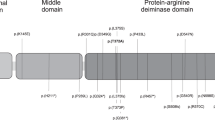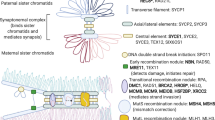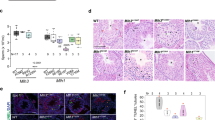Abstract
Recurrent hydatidiform moles (RHM) are aberrant human pregnancies characterized by absence of, or abnormal, embryonic development, hydropic degeneration of chorionic villi, and hyperproliferation of the trophoblast. Biallelic mutations in two maternal-effect genes, NLRP7 and KHDC3L, underlie the causation of RHM in 60% of patients. We performed exome sequencing on a patient with six pregnancy losses, two miscarriages and four HM, and found no variants that affect the functions of the known genes. We found biallelic missense variants that affect conserved amino acids in PADI6 and segregate with the disease phenotype in the family. PADI6 is another maternal-effect gene and a member of the subcortical maternal complex that has been shown to have recessive variants that affect the gene function in four unrelated women with infertility who also experienced early embryonic arrest during preimplantation development after IVF. We demonstrated that PADI6 co-localizes with NLRP7 in human oocytes and preimplantation embryos and reviewed the morphology and genotypes of four products of conception from our patient. Our data expand the involvement of PADI6 to other forms of reproductive loss and highlight the commonality between infertility, miscarriages, and molar pregnancies, in some cases.
Similar content being viewed by others
Log in or create a free account to read this content
Gain free access to this article, as well as selected content from this journal and more on nature.com
or
References
Murdoch S, Djuric U, Mazhar B, et al. Mutations in NALP7 cause recurrent hydatidiform moles and reproductive wastage in humans. Nat Genet. 2006;38:300–2.
Parry DA, Logan CV, Hayward BE, et al. Mutations causing familial biparental hydatidiform mole implicate c6orf221 as a possible regulator of genomic imprinting in the human oocyte. Am J Hum Genet. 2011;89:451–8.
Akoury E, Zhang L, Ao A, Slim R. NLRP7 and KHDC3L, the two maternal-effect proteins responsible for recurrent hydatidiform moles, co-localize to the oocyte cytoskeleton. Human Reprod. 2015;30:159–69.
Zhu K, Yan L, Zhang X, et al. Identification of a human subcortical maternal complex. Mol Hum Reprod. 2015;21:320–9.
Li L, Baibakov B, Dean J. A subcortical maternal complex essential for preimplantation mouse embryogenesis. Dev Cell. 2008;15:416–25.
Meyer E, Lim D, Pasha S, et al. Germline mutation in NLRP2 (NALP2) in a familial imprinting disorder (Beckwith-Wiedemann Syndrome). PLoS Genet. 2009;5:e1000423.
Docherty LE, Rezwan FI, Poole RL, et al. Mutations in NLRP5 are associated with reproductive wastage and multilocus imprinting disorders in humans. Nat Commun. 2015;6:8086.
Alazami AM, Awad SM, Coskun S, et al. TLE6 mutation causes the earliest known human embryonic lethality. Genome Biol. 2015;16:240.
Maddirevula S, Coskun S, Awartani K, Alsaif H, Abdulwahab FM, Alkuraya FS. The human knockout phenotype of PADI6 is female sterility caused by cleavage failure of their fertilized eggs. Clin Genet. 2017;91:344–5.
Xu Y, Shi Y, Fu J, et al. Mutations in PADI6 cause female infertility characterized by early embryonic arrest. Am J Hum Genet. 2016;99:744–52.
Nguyen NM, Zhang L, Reddy R, et al. Comprehensive genotype-phenotype correlations between NLRP7 mutations and the balance between embryonic tissue differentiation and trophoblastic proliferation. J Med Genet. 2014;51:623–34.
Zheng XZ, Hui P, Chang B, et al. STR DNA genotyping of hydatidiform moles in South China. Int J Clin Exp Pathol. 2014;7:4704–19.
Esposito G, Vitale AM, Leijten FP, et al. Peptidylarginine deiminase (PAD) 6 is essential for oocyte cytoskeletal sheet formation and female fertility. Mol Cell Endocrinol. 2007;273:25–31.
Lu X, Gao Z, Qin D, Li L. A maternal functional module in the mammalian oocyte-to-embryo transition. Trends Mol Med. 2017;23:1014–23.
Yurttas P, Vitale AM, Fitzhenry RJ, et al. Role for PADI6 and the cytoplasmic lattices in ribosomal storage in oocytes and translational control in the early mouse embryo. Development. 2008;135:2627–36.
Sebire NJ, Savage PM, Seckl MJ, Fisher RA. Histopathological features of biparental complete hydatidiform moles in women with NLRP7 mutations. Placenta. 2013;34:50–6.
Brown L, Mount S, Reddy R, et al. Recurrent pregnancy loss in a woman with NLRP7 mutation: not all molar pregnancies can be easily classified as either “partial” or “complete” hydatidiform moles. Int J Gynecol Pathol. 2013;32:399–405.
Qian J, Deveault C, Bagga R, Xie X, Slim R. Women heterozygous for NALP7/NLRP7 mutations are at risk for reproductive wastage: report of two novel mutations. Hum Mutat. 2007;28:741.
Slim R, Bagga R, Chebaro W, Srinivasan R, Agarwal N. A strong founder effect for two NLRP7 mutations in the Indian population: an intriguing observation. Clin Genet. 2009;76:292–5.
Sills ES, Obregon-Tito AJ, Gao H, et al. Pathogenic variant in NLRP7 (19q13.42) associated with recurrent gestational trophoblastic disease: data from early embryo development observed during in vitro fertilization. Clin Exp Reprod Med. 2017;44:40–6.
Acknowledgements
This work was supported by the Canadian Institute of Health Research [MOP-130364 and CCI-125687 to RS] and by the National Natural Science Foundation of China [81261120569 and 81370729 to JHQ].
Author information
Authors and Affiliations
Corresponding authors
Ethics declarations
Conflict of interest
The authors declare that they have no conflict of interest.
Rights and permissions
About this article
Cite this article
Qian, J., Nguyen, N.M.P., Rezaei, M. et al. Biallelic PADI6 variants linking infertility, miscarriages, and hydatidiform moles. Eur J Hum Genet 26, 1007–1013 (2018). https://doi.org/10.1038/s41431-018-0141-3
Received:
Revised:
Accepted:
Published:
Issue date:
DOI: https://doi.org/10.1038/s41431-018-0141-3
This article is cited by
-
Variants of NLRP genes encoding subcortical maternal complex components are linked to biparental placental mesenchymal dysplasia
Human Genomics (2025)
-
Subcortical Maternal Complex in Female Infertility: A Transition from Animal Models to Human Studies
Molecular Biology Reports (2025)
-
A novel heterozygous missense variant of PANX1 causes human oocyte death and female infertility
Journal of Ovarian Research (2024)
-
Novel variants in PADI6 genes cause female infertility due to early embryo arrest
Journal of Assisted Reproduction and Genetics (2024)
-
Advances in the genetic etiology of female infertility
Journal of Assisted Reproduction and Genetics (2024)



